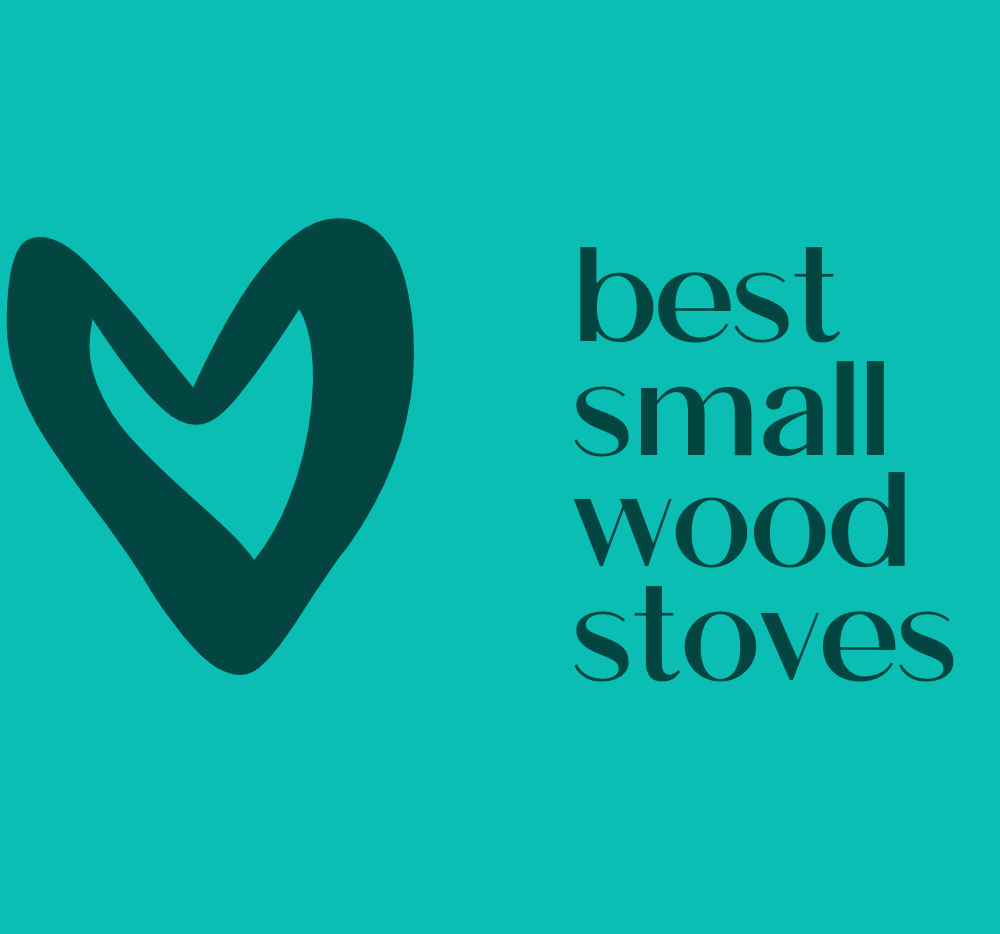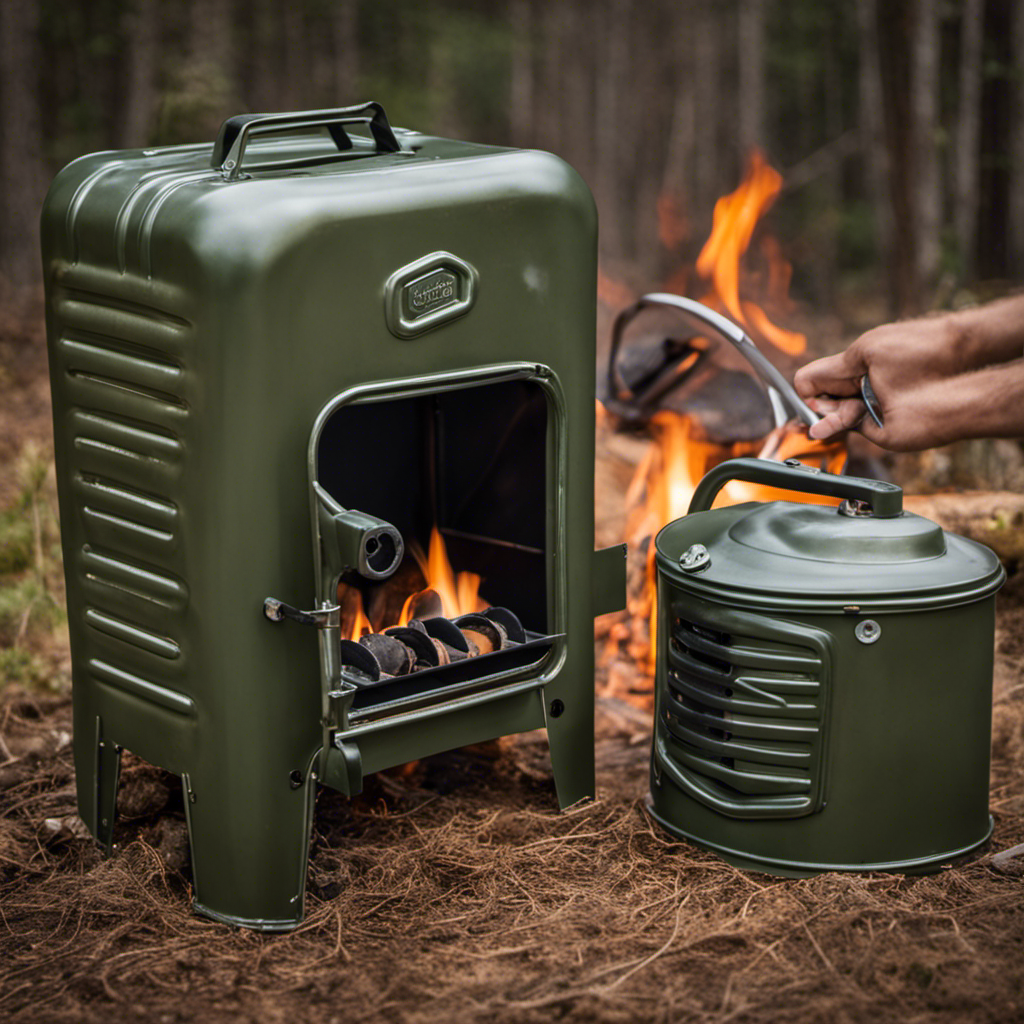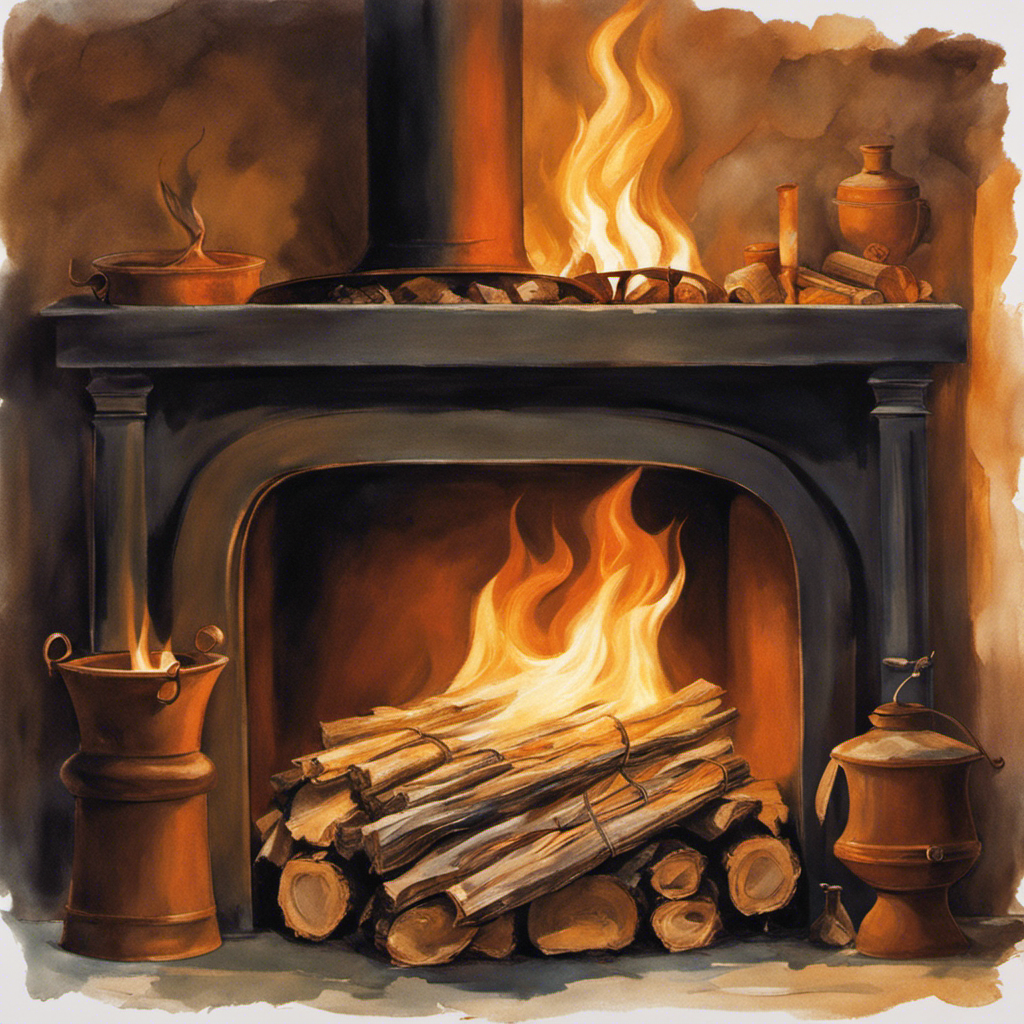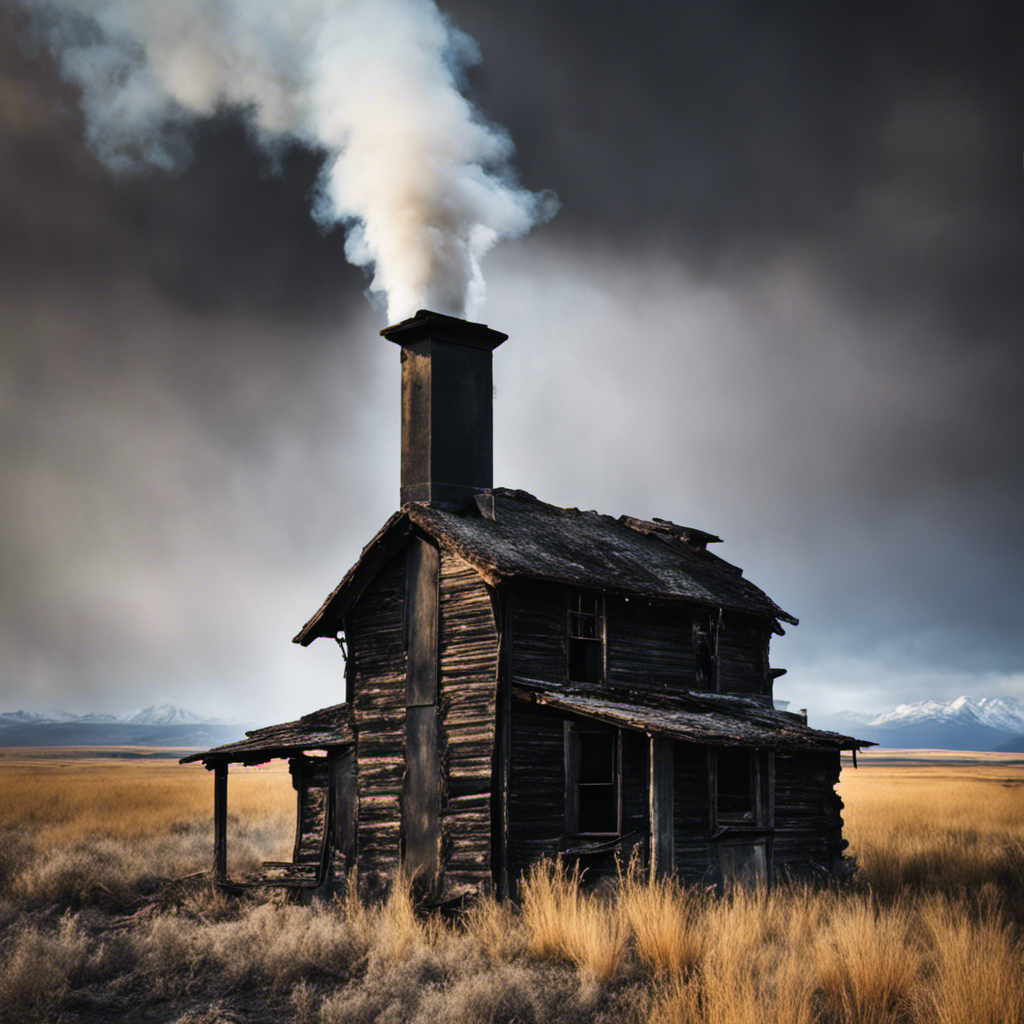The Right Fuel: Choosing Safe and Efficient Wood for Burning
When it comes to choosing the right fuel for burning, there’s more at stake than just warmth. Finding safe and efficient wood is crucial to ensure optimal heat output and minimize environmental impact.
In this article, I’ll dive into the different types of wood, factors to consider when choosing firewood, and the best practices for storing and handling it.
Get ready to become an expert in selecting the perfect wood to keep your fire burning bright and clean.
Key Takeaways
- Hardwoods like oak, maple, ash, and beech produce longer-lasting and hotter fires.
- Softwoods like pine and fir burn faster and are better for starting fires.
- Dry wood burns more efficiently and produces less smoke and creosote buildup.
- Choose firewood sourced locally and certified by recognized organizations like the Forest Stewardship Council to ensure safe and sustainable wood sources.
Different Types of Wood for Burning
I prefer using hardwoods, like oak or maple, for burning because they produce longer-lasting and hotter fires. Hardwoods, such as oak, maple, ash, and beech, are known for their excellent burning properties. They’re denser and have a higher energy content compared to softwoods. This means they burn slower and provide a more sustained heat output. Softwoods, on the other hand, like pine and fir, are less dense and burn faster. They’re better suited for starting fires and providing a quick burst of heat. However, they may not be ideal for long-lasting fires.
It is important to note that different types of wood have varying moisture content. Dry wood burns more efficiently and produces less smoke and creosote buildup in chimneys. Hardwoods generally have a lower moisture content compared to softwoods, making them a better choice for efficient burning. Moisture meters are available to measure the moisture content of firewood, ensuring you select the driest wood possible.
Considering the types of firewood available is the first step in choosing the right wood for burning. However, there are other factors to consider when making your decision.
Factors to Consider When Choosing Firewood
When it comes to selecting firewood, there are several factors that should be taken into consideration.
The type of wood is an important factor to consider when choosing firewood. Hardwoods, such as oak or maple, are known to burn longer and produce more heat compared to softwoods like pine or spruce.
It’s also important to consider the moisture content of the firewood. Wet or green wood can be difficult to burn and can produce excess smoke and creosote buildup in your chimney, increasing the risk of chimney fires. Therefore, it’s recommended to choose seasoned firewood, which has been properly dried for at least six months.
Proper firewood storage is also crucial in maintaining the quality of the wood. Firewood should be stored in a dry and well-ventilated area, off the ground, and protected from rain and snow. This will prevent moisture absorption and ensure that the firewood remains dry and ready to burn efficiently.
Hardwood Vs. Softwood: Which Is Better
As an avid firewood burner, I prefer hardwood over softwood because it burns longer and produces more heat. When it comes to durability, hardwood outshines softwood. Hardwood, like oak or maple, is denser and has a higher energy content, which means it burns slower and provides a longer-lasting fire. Softwood, on the other hand, tends to burn faster due to its lower density and resin content. This means you’ll need to constantly replenish the fire with softwood, resulting in more frequent trips to the woodpile.
In terms of heat production, hardwood is the clear winner. Its higher density and energy content allow it to generate more heat per unit volume compared to softwood. Not only will you stay warm for longer periods, but you’ll also use less wood overall.
However, it’s important to note that softwood can be a suitable choice for quick fires or when you need a fire that starts easily. Softwood, such as pine or spruce, ignites faster due to its higher resin content. So, if you need a fire in a pinch or want to quickly warm up a room, softwood can be a practical option.
Seasoning and Moisture Content of Firewood
One thing to consider when selecting firewood is the seasoning and moisture content, as it directly affects how efficiently the wood will burn. Properly seasoned firewood is wood that has been dried for a period of time, usually between 6 months to a year, allowing it to reach a moisture content of around 20%. This is important because green or wet wood contains a higher moisture content, which makes it harder to ignite and burn.
There are several benefits to using seasoned firewood. Firstly, it burns more efficiently and produces more heat. This is because the moisture content in seasoned wood is significantly lower, allowing it to ignite and burn more easily. Additionally, seasoned firewood produces less smoke and fewer emissions, contributing to better air quality. It also reduces the risk of creosote buildup in your chimney, which can lead to chimney fires.
To ensure that your firewood is properly seasoned, it’s important to store it correctly. Firewood should be stored in a dry, well-ventilated area, preferably off the ground to prevent moisture absorption. Stacking it in a woodshed or using a firewood rack with a cover can help protect it from rain and snow. Regularly inspect your firewood to ensure it’s dry and ready to use.
Safe and Sustainable Wood Sources
I find it important to consider the source of my firewood to ensure it’s both sustainable and environmentally friendly. As we strive to reduce our reliance on fossil fuels and move towards renewable energy sources, it’s crucial to make conscious choices when it comes to heating our homes.
Here are four key factors to consider when choosing safe and sustainable wood sources:
-
Local and Certified: Opt for firewood that’s sourced locally and certified by recognized organizations such as the Forest Stewardship Council (FSC). This ensures that the wood comes from responsibly managed forests and promotes sustainable harvesting practices.
-
Waste Wood: Look for firewood made from waste wood, such as tree trimmings or wood from construction sites. Using waste wood reduces the demand for freshly cut trees and helps minimize the carbon footprint associated with transportation and processing.
-
Fast-growing Species: Consider using firewood from fast-growing tree species, such as poplar or willow. These trees can be harvested more frequently, allowing for sustainable regrowth and reducing the pressure on slower-growing species.
-
Seasoned and Dried: Ensure that the firewood has been properly seasoned and dried to minimize smoke, increase energy efficiency, and reduce the environmental impact of combustion.
Best Wood for Efficient Heat Output
To maximize heat output, it’s important to select a type of firewood that burns efficiently and produces a significant amount of heat. When it comes to choosing the best wood for efficient heat output, there are several factors to consider. One of the most important factors is the wood’s density. Dense woods, such as oak and hickory, tend to burn longer and produce more heat compared to less dense woods like pine or spruce. Additionally, the moisture content of the wood is crucial. Wet or green wood requires more energy to burn off the moisture, resulting in less heat being produced. Dry wood, on the other hand, burns more efficiently and generates higher heat output. Finally, the wood’s age can also affect its burning efficiency. Older, well-seasoned wood burns better than freshly cut wood. Here is a table summarizing the heat output of different types of wood:
| Type of Wood | Heat Output (BTU per cord) |
|---|---|
| Oak | 24 million |
| Hickory | 26 million |
| Pine | 14 million |
| Spruce | 12 million |
Avoiding Wood That Causes Excessive Smoke or Creosote Buildup
When selecting firewood, it’s important to consider types that minimize smoke and creosote buildup for a safer and more enjoyable experience. Here are four key points to keep in mind:
-
Avoid wood with high resin content: Resinous wood, such as pine or spruce, tends to produce more smoke and creosote when burned. This is due to the high levels of sap and volatile compounds present in these woods. Opt for hardwoods like oak, maple, or ash, which have lower resin content and therefore burn cleaner.
-
Properly season your firewood: Moisture content plays a crucial role in smoke and creosote production. Wet or green wood not only burns less efficiently but also creates more smoke and increases the risk of creosote buildup in your chimney. Make sure to properly season your firewood, allowing it to dry for at least six months before use.
-
Regular chimney maintenance: Creosote buildup is a major fire hazard and can lead to chimney fires if not properly managed. Regular chimney inspections and cleanings are essential to remove any creosote deposits and ensure proper airflow. Hire a professional chimney sweep at least once a year to maintain a safe and efficient chimney system.
-
Use a chimney cap or spark arrestor: Installing a chimney cap or spark arrestor can help prevent debris, such as leaves or twigs, from entering your chimney. This not only reduces the risk of blockages but also minimizes the amount of smoke that can escape into your living space.
Storing and Handling Firewood for Optimal Burning Efficiency
When it comes to achieving optimal burning efficiency, proper firewood storage and handling are crucial. Not only does it ensure that the wood is dry and ready to burn, but it also helps prevent insect infestation, which can be a common problem.
To store firewood effectively, it is important to keep it off the ground and protected from rain or snow. A well-ventilated woodshed or covered storage area is ideal. Additionally, stacking the wood properly allows for better air circulation and drying.
Here is a simple table outlining the do’s and don’ts of firewood storage:
| DO’s | DON’Ts |
|---|---|
| Store firewood off the ground | Store firewood directly on the ground |
| Keep firewood covered | Leave firewood exposed to the elements |
| Stack firewood with proper airflow | Stack firewood tightly without any space between the logs |
Preventing insect infestation is also crucial for maintaining the quality of the firewood. Inspect the wood before bringing it indoors, as insects can hide in the bark or crevices. If you notice any signs of infestation, such as tunnels or exit holes, it’s best to leave the wood outside or properly treat it before bringing it inside.
Frequently Asked Questions
Can I Burn Any Type of Wood in My Fireplace or Wood Stove?
I can’t just burn any type of wood in my fireplace or wood stove. It’s important to choose the right fuel for safety and efficiency.
There are alternative fuel options available for fireplaces and wood stoves that can provide better heat output and reduce emissions.
Additionally, it’s crucial to properly dispose of ash from a wood burning appliance to prevent any potential fire hazards.
Researching and understanding the best wood options and disposal methods is essential for a safe and efficient wood burning experience.
How Long Does It Take for Firewood to Properly Season?
To properly season firewood, it typically takes six months to a year. During this time, the wood needs to be stored in a dry, well-ventilated area.
To identify properly seasoned firewood, look for cracks in the ends of the logs, a lighter weight, and a dull sound when two pieces are knocked together.
If you need to speed up the seasoning process, split the wood into smaller pieces and stack them in a sunny, breezy location.
What Are the Potential Dangers of Burning Wood That Is Not Properly Seasoned?
Burning wood that isn’t properly seasoned can pose potential health risks and have a negative environmental impact. When wood isn’t adequately dried, it produces more smoke and releases harmful pollutants into the air, such as carbon monoxide and fine particulate matter. These pollutants can worsen respiratory conditions, like asthma, and contribute to air pollution.
Properly seasoned wood burns more efficiently, producing less smoke and reducing the potential dangers associated with burning unseasoned wood.
Are There Any Specific Types of Wood That Should Be Avoided Due to Their Negative Impact on the Environment?
When considering the environmental impact of burning wood, it’s important to identify the types of wood that should be avoided.
By conducting an environmental impact assessment, sustainable alternatives can be identified.
Certain types of wood, such as tropical hardwoods or endangered species, should be avoided due to their negative impact on the environment.
It’s crucial to choose wood that’s sourced responsibly and doesn’t contribute to deforestation or habitat destruction.
What Are the Best Practices for Storing Firewood to Ensure Optimal Burning Efficiency?
Storing firewood in small spaces and preventing insect infestations are important factors to consider for optimal burning efficiency.
When it comes to storing firewood in limited areas, it’s crucial to stack the wood properly to promote air circulation and prevent moisture buildup. Additionally, using a cover or tarp can protect the wood from rain and snow.
To prevent insect infestations, it’s recommended to keep the firewood off the ground and away from buildings. Regularly inspecting the wood for signs of pests is also essential.
Conclusion
In conclusion, choosing the right wood for burning is crucial for both safety and efficiency. By considering factors such as the type of wood, its moisture content, and sustainable sourcing, one can ensure a clean and efficient burn.
For example, a homeowner in a rural area who relies on a wood-burning stove for heating may opt for seasoned hardwood from a sustainable source, such as a local forest, to maximize heat output and minimize environmental impact.
By making informed choices, individuals can enjoy the warmth and comfort of a fire while minimizing their carbon footprint.










